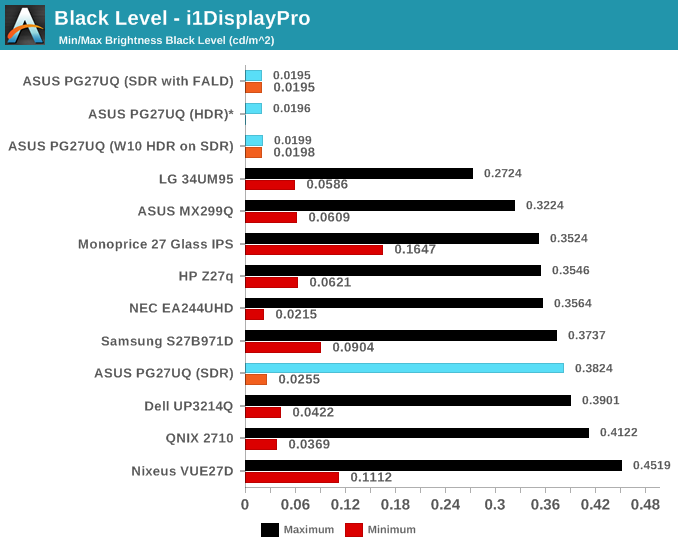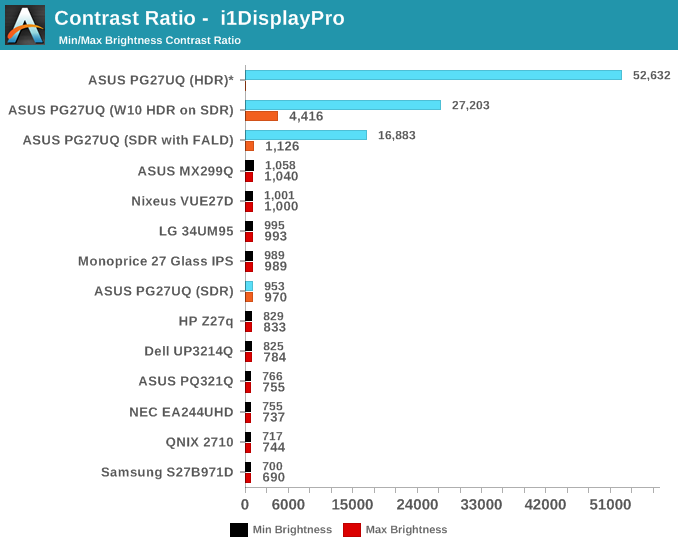The Asus ROG Swift PG27UQ G-SYNC HDR Monitor Review: Gaming With All The Bells and Whistles
by Nate Oh on October 2, 2018 10:00 AM EST- Posted in
- Monitors
- Displays
- Asus
- NVIDIA
- G-Sync
- PG27UQ
- ROG Swift PG27UQ
- G-Sync HDR
Brightness and Contrast
Going straight into the brightness and contrast metrics, we know HDR's calling card is to permit those bright whites and dark blacks. For DisplayHDR 1000, and UHD Premium, 1000 nits (the common non-SI term for cd/m2) is the requirement. So for brightness of white levels, it's no surprise that in HDR mode the PG27UQ reaches that coveted mark.
Outside of HDR, brightness is also useful in gauging visibility/usability in conditions of bright and direct ambient light, i.e. outdoors. For moderately lit indoor use, the typical 200 to 300 nit range of desktop monitors is more than sufficient. In terms of factory defaults, the PG27UQ is set at 80 for brightness, which is around 266 nits. 1000 nits is much too bright for day-to-day usage, as is 500 nits.

*In HDR mode, there is an adjustable 'reference white' setting, defaulted at 80 nits, instead of a brightness setting. At that default setting, the PG27UQ displayed the HDR test pattern at 1032 nits.
Because HDR has a static 'reference white' level instead of brightness, there isn't really an equivalent to minimum brightness white level as it isn't utilized in the same way; for the PG27UQ, reference white can be set between 20 to 300 nits.
Otherwise, enabling the Windows 10 'HDR and Wide Color Gamut' mode puts the monitor into its HDR mode; additionally, that Windows 10 setting provides a brightness slider governing SDR content while in HDR mode. So at 100% SDR brightness, the display pushes past 500 nits. For users, it works nicely to avoid SDR dimness when HDR is enabled, and also providing the option to boost up to much higher brightness if desired.

*Represents black levels corresponding to the default 'reference white' setting of 80 nits.
IPS-type panels are often known for their 'backlight bleed' and so relatively higher black levels. Without its local dimming capability, the PG27UQ isn't much of an exception. Enabling variable backlighting (FALD) in the OSD brings the black levels to HDR tier performance, and can be enabled on SDR mode at the cost of maximum brightness white levels.

*Contrast ratios calculated from default reference white of 80 nits
The good range between bright whites and dark blacks translate into high contrast ratios for the PG27UQ. While we don't have any other HDR monitors for comparison, the contrast ratios are really in their own class, especially as only HDR content will take advantage of the brightness and be (properly) displayed. Otherwise, in pure SDR mode, the PG27UQ resembles a solid IPS-type SDR monitor. Just enabling the direct LED backlighting in SDR mode improves contrasts considerably on the strength of its black levels.










91 Comments
View All Comments
imaheadcase - Tuesday, October 2, 2018 - link
3840x1600 is the dell i mean.Impulses - Tuesday, October 2, 2018 - link
The Acer Predator 32" has a similar panel as that BenQ and adds G-Sync tho still at a max 60Hz, not as well calibrated out of the box (and with a worse stand and controls) but it has dropped in price a couple times to the same as the BenQ... I've been cross shopping them for a while because 2 grand for a display whose features I may or may not be able to leverage in the next 3 years seems dubious.I wanted to go 32" too because the 27" 1440p doesn't seem like enough of a jump from my 24" 1920x1200 (being 16:10 it's nearly as tall as the 16:9 27"erd), and I had three of those which we occasionally used in Eyefinity mode (making a ~40" display). I've looked at 40-43" displays but they're all lacking compared to the smaller stuff (newer ones are all VA too, mostly Phillips and one Dell).
I use my PC for photo editing as much as PC gaming but I'm not a pro so a decent IPS screen that I can calibrate reasonably well would satisfy my photo needs.
Fallen Kell - Tuesday, October 2, 2018 - link
It is "almost" perfect. It is missing one of the most important things, HDMI 2.1, which has the bandwidth to actually feed the panel with what it is capable of doing (i.e. 4k HDR 4:4:4 120Hz). But we don't have that because this monitor was actually designed 3 years ago and only now finally coming to market, 6 months after HDMI 2.1 was released.lilkwarrior - Monday, October 8, 2018 - link
HDMI 2.1 certification is still not done; it would not have been able to call itself a HDMI 2.1 till probably late this year or next year.imaheadcase - Tuesday, October 2, 2018 - link
The 35 inch one has been canceled fyi. Asus rep told me when inquired about it just a week ago, unless in a week something has changed. Reason being panel is not perfect yet to mass produce.That said, its not a big loss, even if disappointing. Because HDR is silly tech so you can skip this generation
EAlbaek - Tuesday, October 2, 2018 - link
I bought one of these, just as they came out. Amazing display performance, but the in-built fan to cool the G-Sync HDR-module killed it for me.It's one of those noisy 40mm fans, which were otherwise banned from PC setups over a decade ago. It made more noise than the entirety of the rest of my 1080 Ti-SLI system combined. Like a wasp was loose in my room all the time. Completely unbearable to listen to.
I tried to return the monitor as RMA, as I thought that couldn't be right. But it could, said the retailer. At which point I chose to simply return the unit.
In my case, these things will have to wait, till nVidia makes a new G-Sync HDR module, which doesn't require active cooling. Plain and simple. I'm sort of guessing that'll fall in line with the availability of micro-LED displays. Which will hopefully also be much cheaper, than the ridiculously expensive FALD-panels in these monitors.
imaheadcase - Tuesday, October 2, 2018 - link
Can't you just replace the fan yourself? I read around the time of release someone simply removed fan and put own silent version on it.EAlbaek - Tuesday, October 2, 2018 - link
No idea - I shouldn't have to void the warranty on my $2000 monitor, to replace a 40mm fan.madwolfa - Tuesday, October 2, 2018 - link
Is that G-Sync HDR that requires active cooling or FALD array?EAlbaek - Tuesday, October 2, 2018 - link
It's the G-Sync HDR chip, apparantly.